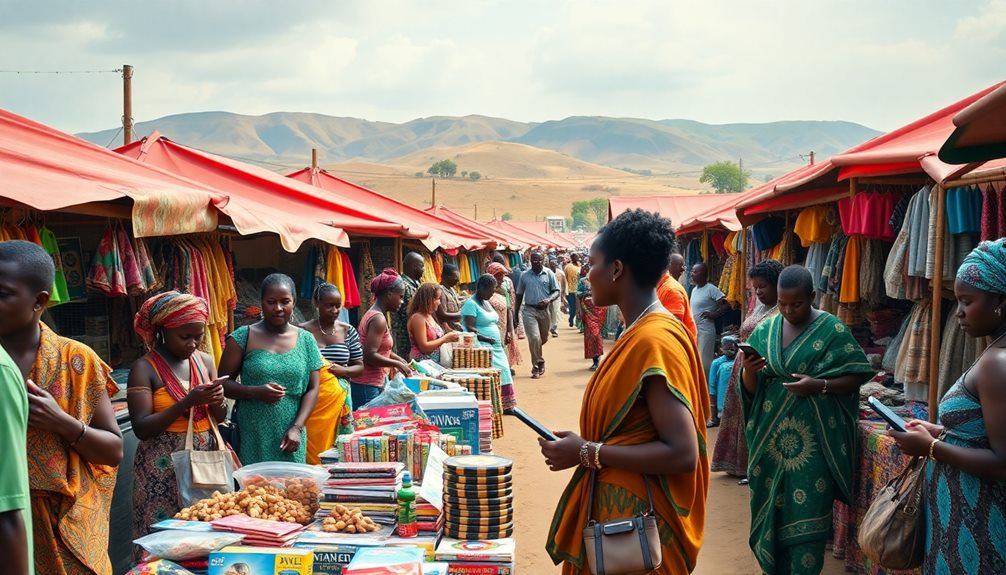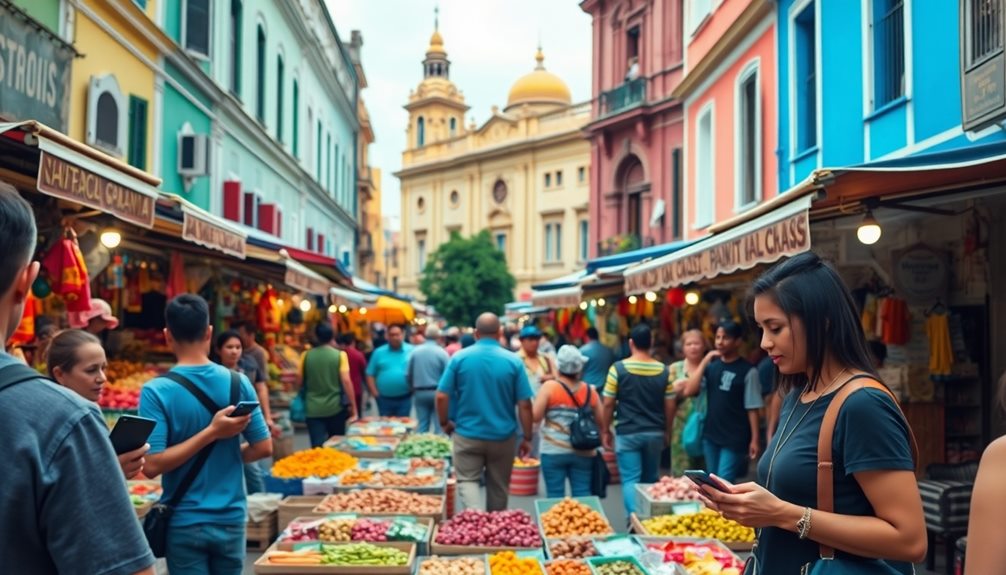To succeed in Africa's booming e-commerce market, you need tailored strategies for each country. Focus on local preferences, like mobile payment solutions in Kenya and cash-on-delivery options in Nigeria. Understand consumer behavior—young, digital-savvy shoppers are key. Don't overlook the barriers, such as high transaction costs and limited logistics infrastructure that can impact growth. Collaborating with local partners can enhance your efficiency. Finally, guarantee compliance with varying regulations to build consumer trust. There's much more to uncover about effective strategies for each market, so exploring tailored approaches can set you on the right path.
Key Takeaways
- Kenya's National E-Commerce Strategy emphasizes secure online shopping and accessibility for marginalized groups to boost digital economy participation.
- South Africa focuses on enhancing payment security through two-factor authentication and promoting e-wallets for efficient transactions.
- Nigeria leverages mobile money platforms like OPay and Paga due to low credit card ownership, catering to local payment preferences.
- Egypt addresses logistics challenges by investing in transportation networks and partnerships with established shipping providers to improve delivery services.
- Morocco implements regulatory reforms and digital literacy initiatives to foster a safer e-commerce environment and promote consumer trust.
National E-Commerce Strategies
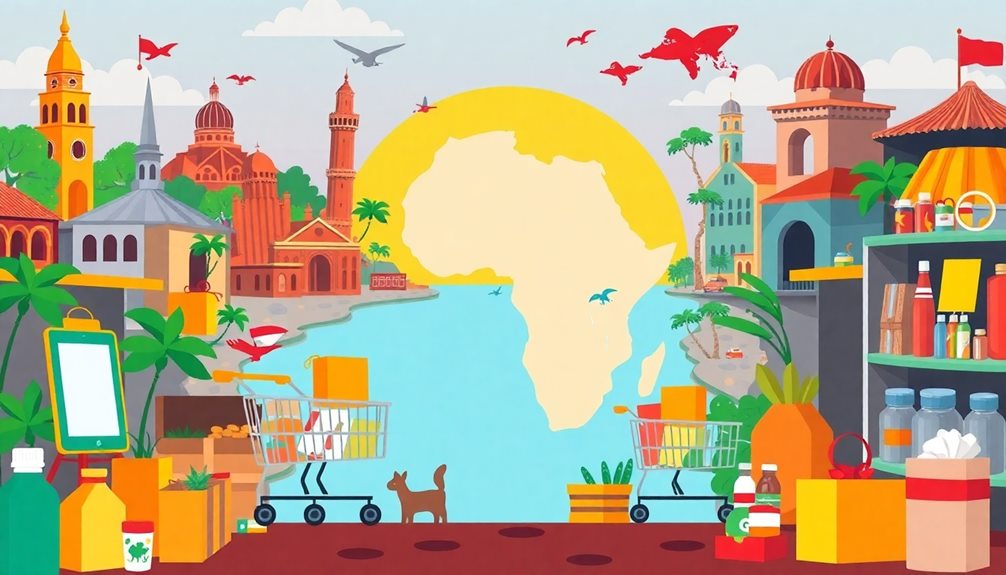
National e-commerce strategies are increasingly becoming essential for countries looking to boost their digital economies. Take Kenya, for instance, which launched its National E-Commerce Strategy on December 13, 2023, aiming to enhance secure e-commerce and build trust among businesses and consumers.
This strategy prioritizes accessibility for marginalized groups, ensuring everyone can participate in the digital economy. Additionally, the rise of alternative investments in emerging markets emphasizes the need for robust digital platforms to support diverse business models. By focusing on reducing e-commerce costs and improving delivery speed, Kenya's approach seeks to create a more inclusive environment.
The strategy also emphasizes the importance of inter-ministerial collaboration, showing that effective implementation requires teamwork across various sectors. Strengthening legal frameworks is another goal, which can help foster a safer and more reliable online shopping experience.
However, challenges remain. High digital payment transaction costs and uneven network coverage hinder many potential participants from engaging in e-commerce. Addressing these issues is vital for enhancing financial inclusion and ensuring that everyone can benefit from the growing digital marketplace.
Supported by UNCTAD and international partners, Kenya's strategy aligns with regional initiatives, signaling a commitment to building a thriving e-commerce landscape across East Africa.
Current Market Landscape

As Kenya and other countries implement their national e-commerce strategies, the current market landscape across Africa shows promising growth potential. The African e-commerce market was valued at approximately $277 billion in 2023, with an impressive compound annual growth rate (CAGR) of 14.4% projected through 2032. Countries like South Africa, Nigeria, Egypt, Morocco, and Kenya lead this growth by leveraging high internet penetration and diverse consumer bases.
Understanding provincial vs. federal regulations is also essential as these countries navigate their unique e-commerce environments.
One of the key e-commerce trends is the remarkable mobile internet usage in Africa, which exceeds the global average by 13%. This presents a significant opportunity for mobile commerce as smartphone access continues to grow. As you engage with online shopping platforms, you'll notice that increasing digital literacy, economic stability, and a burgeoning middle class are driving this shift.
Moreover, payment solutions are evolving to meet local needs, with preferences for mobile money services, such as mPesa in Kenya, and cash-on-delivery options that reflect unique market characteristics.
As these trends develop, you'll find that Africa's e-commerce landscape is becoming more dynamic and accessible, paving the way for future innovations and opportunities.
Key Challenges and Barriers
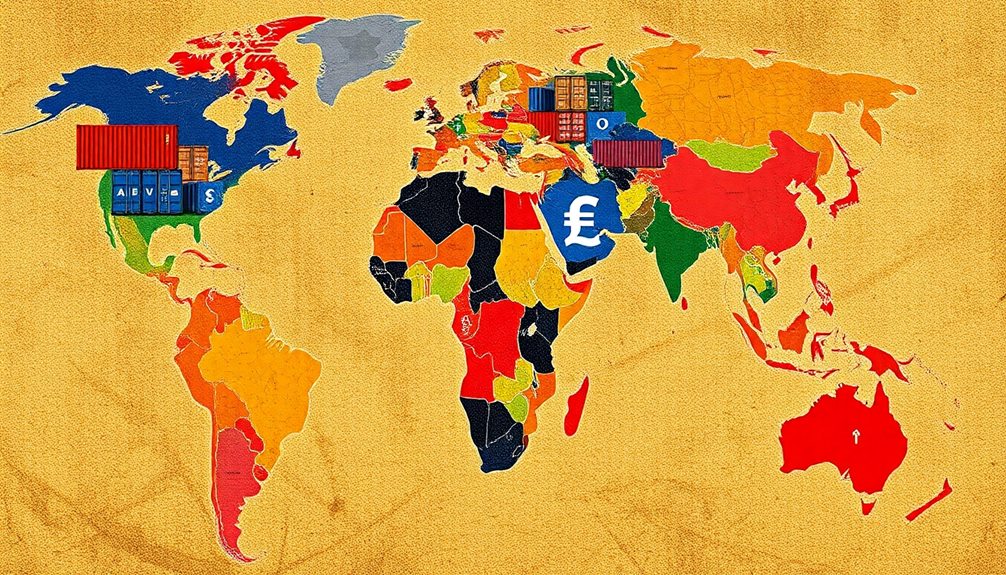
When you consider African e-commerce, you'll quickly notice some significant challenges. High costs of digital transactions and limited access to devices can make it tough for many to participate, especially in rural areas.
Additionally, the lack of robust infrastructure can hinder delivery and logistics, further complicating e-commerce efforts.
Plus, maneuvering regulatory hurdles can complicate things for businesses trying to thrive in this market, as they must remain compliant with various investment regulations.
Digital Access Barriers
Digital access barriers present significant challenges for many Africans trying to engage in e-commerce. These hurdles often limit your ability to shop online and participate in the digital economy.
Here are some key issues you might face:
- Limited Device Access: Many citizens, especially in rural areas, struggle to obtain digital devices, hindering their e-commerce participation.
- Uneven Network Coverage: Certain regions lack reliable internet services, making online shopping difficult or even impossible.
- High Costs: The expenses associated with digital payment transactions can deter low-income consumers, making e-commerce less accessible.
- Regulatory Hurdles: Issues like data privacy and dispute resolution can create additional obstacles for you as a consumer or business owner.
These digital access barriers not only restrict participation in e-commerce but also exacerbate existing inequalities.
Addressing these challenges is essential for creating a more inclusive digital marketplace where everyone can benefit.
Regulatory Hurdles and Costs
Maneuvering regulatory hurdles and costs in African e-commerce can feel overwhelming for many businesses and consumers. Complex tax structures and stringent compliance requirements often raise operational costs, making it difficult for you to compete or attract foreign investment.
If you're a business owner, you might find that high costs associated with digital payment transactions further limit your ability to reach a broader audience, especially in regions lacking robust banking infrastructure.
Furthermore, varying data privacy laws across countries create additional compliance burdens that complicate your efforts in cross-border transactions and data management. This inconsistency in regulatory environments can lead to confusion and increased costs as you try to scale your operations regionally.
Additionally, the lack of effective dispute resolution mechanisms can foster consumer mistrust, which discourages online purchases. You may find that potential customers are hesitant to engage in e-commerce due to these uncertainties.
Addressing these regulatory hurdles and understanding the associated costs is essential for anyone looking to thrive in Africa's dynamic e-commerce landscape. By maneuvering through these challenges effectively, you can reveal significant opportunities for growth and innovation.
Consumer Behavior Insights

Consumer behavior in African e-commerce markets reveals a dynamic landscape shaped by unique preferences and challenges. As you navigate this space, you'll notice several key insights that can enhance your strategy:
- Cashless Payments: Many consumers prefer mobile payment options, with services like mPesa in Kenya boasting over 56 million users. This trend boosts consumer trust in online transactions.
- Price Sensitivity: Expect a strong demand for bulk discounts and promotional deals, especially in today's challenging economic climate. Understanding this can help you tailor your offerings effectively.
- Digital Literacy: With a median age of 20, the young population is becoming increasingly digitally literate. This shift facilitates greater engagement with e-commerce platforms, so targeting this demographic can be beneficial.
- Social Commerce: Platforms like Instagram and Facebook are reshaping consumer engagement, particularly among tech-savvy users. Leveraging these channels can enhance your visibility and sales.
Payment Method Preferences

Payment methods in African e-commerce markets are as varied as the continent's cultures, reflecting local preferences and economic realities.
In Kenya, for instance, mobile payment solutions like MPESA dominate, boasting over 56 million users who prefer cashless transactions for their security and convenience.
Meanwhile, in Nigeria, the e-commerce landscape relies heavily on mobile money platforms such as OPay and Paga, as only 1.6% of the population owns a credit card. This makes alternative payment methods essential for successful transactions.
Across various African countries, cash-on-delivery remains a popular choice, offering a sense of security for consumers who may be hesitant to engage in digital payments due to trust issues.
In South Africa, however, payment cards are increasingly favored, bolstered by enhanced security measures like two-factor authentication. There's also a growing trend towards e-wallets for quick transactions.
To thrive in these diverse markets, e-commerce platforms must adopt localized payment strategies that cater to regional preferences.
Understanding these preferred methods not only enhances transaction success rates but also builds consumer trust in the evolving digital landscape.
Logistics and Delivery Solutions
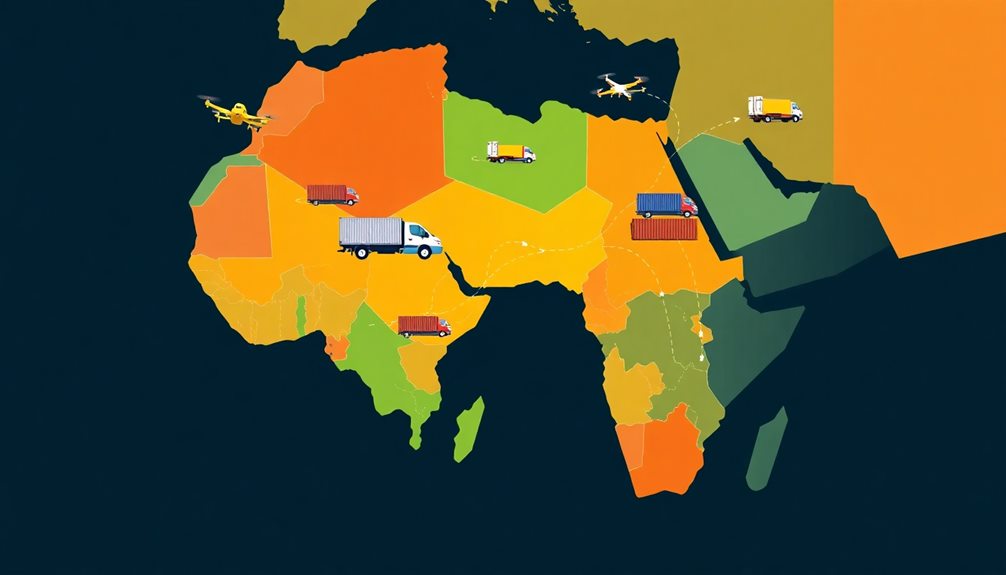
In the fast-paced world of African e-commerce, efficient logistics and delivery solutions are essential for meeting rising consumer expectations. As you navigate this landscape, consider the following factors that impact logistics infrastructure and delivery efficiency:
- Last-Mile Delivery: This is important, especially in urban areas where consumers expect quick service. Investing in effective last-mile strategies can notably enhance delivery speed.
- Partnerships: Collaborating with established shipping providers, like Jumia does, can streamline your logistics operations, ensuring that you meet customer demands without compromising service quality.
- Infrastructure Investments: Limited logistics infrastructure hinders delivery efficiency. Investing in better transportation and distribution networks is necessary to improve your overall service.
- Consumer Trust: Reliable delivery is essential for building consumer trust. Operational challenges, such as Sendy's shutdown, highlight the need for stable logistics solutions to maintain customer confidence in your brand.
Future Growth Opportunities

The future of African e-commerce is brimming with opportunities, as the market is set to soar from $277 billion in 2023 to nearly $940 billion by 2032. This impressive growth is fueled by increasing internet penetration and a young, tech-savvy population, with an estimated 500 million e-commerce users by 2025. As you tap into this market, keep an eye on the rise of mobile payment solutions like mPesa and OPay, which enhance transaction efficiency and build consumer confidence.
Here's a snapshot of the projected growth:
| Year | Market Size (in billion $) |
|---|---|
| 2023 | 277 |
| 2025 | 400 |
| 2030 | 700 |
| 2032 | 940 |
With a compound annual growth rate (CAGR) of 14.4% projected from 2024 to 2032, there's no doubt that e-commerce growth will be driven by escalating consumer demand and improved digital infrastructure. Countries like Nigeria and South Africa stand at the forefront, requiring tailored strategies to effectively tap into their unique consumer behaviors and challenges.
Frequently Asked Questions
What Is the E-Commerce Strategy of Kenya?
Kenya's e-commerce strategy focuses on enhancing secure online shopping for everyone, especially marginalized groups. It addresses barriers like device access and high costs, aiming to boost participation through collaboration and improved consumer confidence.
What Is the Largest Ecommerce Market in Africa?
You'll find South Africa as the largest e-commerce market in Africa, with a booming $50 billion size. High internet usage, mobile commerce growth, and strong logistics support its rapid online shopping expansion and success.
What Is the Potential of E-Commerce in Africa?
You might think e-commerce in Africa is just starting, but it's booming! With over 500 million users by 2025 and rising mobile commerce, the potential for growth and innovation is enormous. Don't miss out!
What Is the EAC E-Commerce Strategy?
The EAC e-commerce strategy focuses on enhancing regional integration, promoting cross-border trade, and harmonizing regulations. It emphasizes digital infrastructure, improved logistics, consumer protection, and cybersecurity to foster trust and boost online transactions among member states.
Conclusion
In the bustling world of African e-commerce, you'd think overcoming challenges would be the hardest part. Ironically, it's the opportunities for growth that often trip us up! As you navigate country-specific strategies, remember that understanding consumer behavior and payment preferences isn't just a task—it's a treasure map leading to success. Embrace the logistics hurdles; they're merely stepping stones to innovation. So, while the path may seem tough, it's the potential waiting ahead that truly keeps you on your toes!
